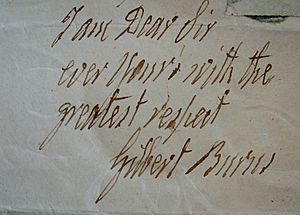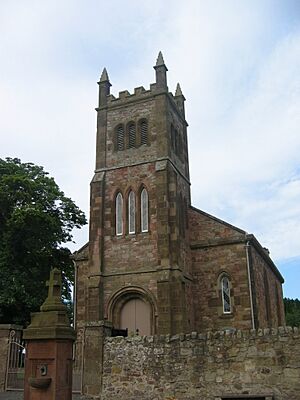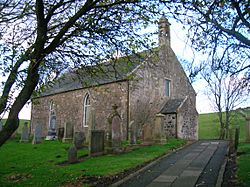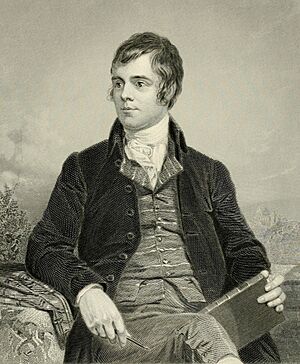Gilbert Burns (farmer) facts for kids
Quick facts for kids
Gilbert Burns
|
|
|---|---|

Gilbert Burns' signature
|
|
| Born | 28 September 1760 Alloway, South Ayrshire, Scotland
|
| Died | 8 April 1827 Bolton, East Lothian, Scotland
|
| Occupation | Farmer and then factor |
| Spouse(s) | Jean Breckenridge |
| Children | 11 |
| Parent(s) | William Burnes Agnes Broun |
Gilbert Burns (1760 – 1827) was the younger brother of the famous Scottish poet, Robert Burns. He was born in Alloway, Scotland. Gilbert married Jean Breckenridge in 1791. They had six sons and five daughters. He passed away in 1827 at the age of 66 and was buried in Bolton, East Lothian, Scotland. Gilbert's writings are very important. They have helped us learn a lot about the life of his well-known brother.
Contents
Gilbert's Early Life and Family
Gilbert was born on September 28, 1760. His older brother, Robert Burns, was born in 1759. Gilbert had five other siblings: Agnes, Annabella, William, John, and Isabella. Their parents were William Burnes and Agnes Broun. Gilbert was named after his grandfather on his mother's side.
In 1766, Gilbert's family moved from Alloway to their first rented farm, Mount Oliphant. Life there was very tough. Gilbert wrote about how hard they had to work just to survive. Their diet was very simple, and they rarely ate meat.
In 1777, the family moved again to a 130-acre farm called Lochlea. They lived there for seven years. During this time, Gilbert and Robert rented a small piece of land from their father. They used it to grow flax.
Later, in 1783, Gilbert and Robert rented the 118-acre Mossgiel Farm. Gilbert said that Mossgiel was not profitable. The brothers had to give up the lease in 1788.
Gilbert once shared his thoughts on farm work. He said that most farm tasks were fine. But he found thrashing (separating grain from stalks) to be very boring. He thought the person who invented the thrashing machine deserved a statue!
Gilbert's father had a big impact on him. His father taught him that true happiness should not depend on food or drink. Gilbert learned this lesson early. He felt bad if he ever spent money on sweets. This teaching stayed with him his whole life.
In 1780, Gilbert helped start the Tarbolton Bachelors' Club.
Gilbert's Education
Gilbert started school at William Campbell's school in Alloway Mill. But the school closed soon after. So, Gilbert's father hired John Murdoch to teach his children. John Murdoch thought Gilbert was a very smart student. He believed Gilbert had a better imagination than his brother Robert at that age. Gilbert kept going to school even after the family moved. He stopped when the school closed in 1768.
Gilbert said that life at Mount Oliphant was very quiet. They rarely saw anyone outside their family. There were no other boys their age nearby. Gilbert also shared that his father treated him like an adult. They would talk about many things while working. His father wanted to educate him and teach him good morals.
In 1772, Gilbert went to the Dalrymple parish school every other week. His father needed him to help with farm chores. Even at this young age, Gilbert was reading difficult books. He did not go to the school in Kirkoswald, which his brother Robert famously attended.
Gilbert's religious education came partly from his father at home. His father had written a book called A Manual of Religious Belief for this purpose. After his father died, Gilbert kept the book. He later gave it to the Robert Burns Birthplace Museum.
Gilbert's Married Life and Career
On June 21, 1791, Gilbert married Jean Breckenridge (1764 – 1841). They were married at Craigie, near Ayr. Gilbert and Jean had 11 children. Their names were Agnes, Anne, Gilbert, Isabella, James, Janet, Jean, John, Robert, Thomas, and William.
Gilbert's mother also lived with the family until she died in 1820. His unmarried sister, Annabella, was also part of their home. She lived five years longer than Gilbert.
Gilbert left Mossgiel Farm in 1798. He then farmed at Dinning for two years. He was known for making excellent cheese there. He also brought the Ayrshire method of dairy farming to the area.
After Dinning, Gilbert became an estate manager at Morham West Mains in East Lothian. He worked there for four years. Later, Gilbert spent the rest of his life as the factor (manager) of the Lennoxlove estates. These estates belonged to Lady Katherine Blantyre. During this time, he lived with his family near Haddington.
Gilbert was also the treasurer of the Bolton Bible Society. In 1809, he helped finish the building of Bolton church. In 1808, he became an Elder of the Church. This meant he had special duties in several local areas.
One of Gilbert's sons, Thomas, became a minister. He was one of the people who helped found Dunedin in New Zealand. A part of Dunedin is even named Mosgiel after the farm Gilbert and Robert once worked on.
Gilbert and Freemasonry
Like his older brother Robert, Gilbert was also a Freemason. He joined Lodge St James (Tarbolton) on March 1, 1786.
Gilbert's Death
Gilbert Burns died in April 1827, at the age of 66. He was buried in Bolton churchyard. The family tombstone there also records the deaths of his mother and five of his children. His sister Annabella was the last to be buried there in 1832.
The tombstone text lists the names and death dates of his children: Isabella, Agnes, Janet, Jean, and John. It also mentions his mother, Agnes Brown. The stone states that Gilbert Burns died on April 8, 1827.
Gilbert's wife, Jean, died in 1841 at the age of 77. She passed away at her son James's house.
Gilbert's Connection to Robert Burns
It is believed that Robert Burns saw Gilbert as his equal in intelligence. He also considered Gilbert his trusted friend.
Gilbert shared important details about Robert's health when he was young. He said Robert often had headaches and felt faint.
Gilbert also mentioned that Robert was shy around women when he was young. But as he grew older, Robert loved spending time with young ladies. Gilbert said that Robert was very respectful towards women until he was about 23. He wanted to be seen as a good husband.
Gilbert was the one who first introduced David Sillar to Robert. David later became a close friend of Robert Burns.
Gilbert provided extra information for a book about Robert Burns in 1820. He was paid for his help.
In 1784, Gilbert told Robert that he should publish his poems. He gave Robert helpful advice on his poem Epistle to Davie. Gilbert thought he was the first person to suggest that Robert become a published poet. He even helped Robert get 70 people to subscribe to his first book of poems.
After Robert Burns died, Gilbert wrote a letter. He was worried that some of Robert's private letters might be published. He felt this could harm Robert's reputation and upset his friends.
Gilbert's writings are very important for people who study Robert Burns. They give us many clues about where Robert's famous poems came from.
Other Interesting Facts
Unlike his brother, Gilbert was an active member of the Mauchline Conversation Society. This group met to talk about many different topics, like moral questions and politics.
Sir James Shaw, who was the Lord Mayor of London, was Gilbert's nephew through his wife. Sir James helped Robert Burns's children with their careers.
See also
- Jean Armour
- Agnes Broun
- Agnes Burns (Sister)
- Elizabeth 'Betty' Burns (Niece)
- Isabella Burns (Sister)
- William Burnes
- Robert Burnes (1719-1789)




